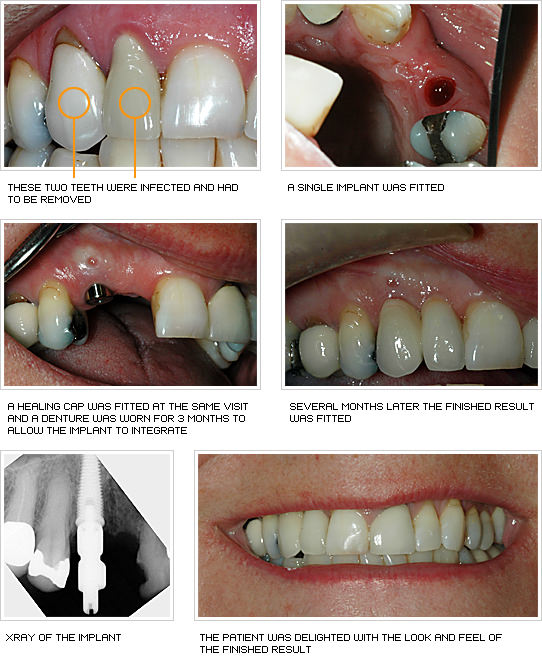9 Simple Techniques For Dental Sense
9 Simple Techniques For Dental Sense
Blog Article
The Ultimate Guide To Dental Sense
Table of ContentsThe Only Guide for Dental Sense3 Easy Facts About Dental Sense ExplainedDental Sense for BeginnersAn Unbiased View of Dental Sense
are clinical devices surgically dental implanted into the jaw to bring back an individual's capacity to eat or their look. They supply support for artificial (phony) teeth, such as crowns, bridges, or dentures. When a tooth is shed due to injury or disease, a person can experience complications such as rapid bone loss, defective speech, or adjustments to chewing patterns that result in discomfort.Dental dental implant systems contain a dental implant body and oral implant joint and might also include an abutment addiction screw. Dental implant vs bridge. The oral implant body is operatively inserted in the jawbone instead of the tooth's root. The dental implant abutment is normally connected to the implant body by the abutment addiction screw and extends via gum tissues right into the mouth to support the attached synthetic teeth
(https://www.gaiaonline.com/profiles/dentalsense1/46992240/)Framework of The Oral Implant System choosing oral implants, talk to your oral copyright about the prospective advantages and dangers, and whether you are a prospect for the procedure. Points to take into consideration: Your general health is an important element in determining whether you are a great prospect for dental implants, for how long it will take to heal, and the length of time the implant might stay in location.
Cigarette smoking might affect the recovery procedure and reduce the lasting success of the dental implant. The healing process for the dental implant body may take numerous months or longer, during which time you generally have a short-term joint instead of the tooth. the oral implant treatment: Meticulously comply with the dental hygiene instructions offered to you by your oral provider.
The Ultimate Guide To Dental Sense
Implant failure can result in the demand for an additional medical procedure to fix or change the dental implant system. Recovers the capability to eat Restores aesthetic look Helps keep the jawbone from diminishing because of bone loss Protects the wellness of the bordering bone and gum tissues Assists maintain nearby (nearby) teeth stable Boosts lifestyle Damage to surrounding natural teeth throughout implant placement Injury to the surrounding cells during surgical procedure, such as sinus perforation Injury throughout surgery (as an example, crack of surrounding jawbone) Insufficient feature, such as seeming like the teeth do not bite with each other generally An experience that the tooth hangs or turning in position resulting from a joint screw loosening Implant body failure (looseness of the dental implant body) as a result of systemic infection, which might be most likely in people with unrestrained diabetics issues because of local infection in bone and gum tissues sustaining the dental implant body as a result of delayed recovery, which might be most likely in people who smoke Problem cleansing the gum tissues around the implant, causing inadequate dental health Untreated periodontal disease Post-surgical feeling numb due to nerve impingement or damage Constantly alert healthcare companies and imaging professionals that you have oral implants before any type of magnetic vibration imaging (MRI) or x-ray treatments.
FDA is not knowledgeable about any type of unfavorable occasions reported for MRI or x-ray treatments with oral implants. Oral implants systems are commonly constructed from products that adhere to worldwide agreement criteria of the International Company for Standardization (ISO) or ASTM International. These criteria have information of what makes a safe material.

A dental implant is a framework that replaces a missing tooth. With screw-like gadgets, the specialist inserts an implant into the jawbone, and it acts as an anchor for a synthetic tooth, called a crown.
All About Dental Sense
Some individuals are not qualified for dental implant surgical procedure. It is for oral doctors to operate individuals with: severe illnessuncontrollable metabolic diseasebone or soft tissue disease or infectionIf these issues are dealt with, a person can have the surgical treatment. In, dental specialists avoid operating individuals with: If people with any of the above go through oral implant surgery, there is a greater danger of the implant falling short.

Dental dental implant surgical treatment is a customized procedure. It's not the very same for every person. The complying with offers a general review of what you can expect your dental expert, dental surgeon, periodontist or prosthodontist to do: Put the dental implant operatively. Offer you time to recover. Affix the post and final crown, bridge or denture.
Next, your surgeon will very carefully position the oral implant into your jaw. Your surgeon will reposition your gums and shut the incision with stitches. If your dental implant is near the front of your mouth, your dental expert will certainly make a short-term tooth for you to put on up until you recover. That means, you won't have a space in your smile while you recuperate.
About Dental Sense
Your service provider can inform you what to anticipate in your scenario. Throughout the recovery stage, your jawbone should fuse to the dental implant. This process, called osseointegration, is important for stability and long-lasting success. This process can take anywhere from three to nine months. In many cases, it might take longer.
When your implant heals, your dental professional can attach the joint (small adapter blog post) and your final repair (crown, bridge or denture). This normally takes about one hour to complete and might call for a second minor surgical treatment. You should not feel any discomfort throughout your dental implant procedure because your service provider will certainly use medicine to numb your periodontals.
Report this page